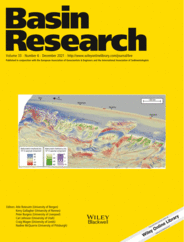
Full text loading...
 , Tiago M. Alves1
, Tiago M. Alves1 , Marco Antonio Caçador Martins‐Ferreira2
, Marco Antonio Caçador Martins‐Ferreira2
Distal slope and basin depositional systems in deep waters of the Pará‐Maranhão Basin, Equatorial Brazil, are investigated using a high‐resolution 3D seismic volume, borehole data and multispectral satellite imagery. A Neogene calciclastic submarine fan and a series of channel‐levee systems are analysed at water depths of 100–3,500 m. Channel‐levee systems have sinuous and straight morphologies and are of different sizes. Their origin is related to turbidity flows sourced and funnelled from the carbonate shelf to submarine canyons and gullies, as well as from areas with marked slope instability. A mixed calciclastic‐siliciclastic sediment input is recognised with autochthonous calcarenites and calcilutites comprising the bulk of sediment on the mid and outer continental shelf. Minor amounts of siliciclastic sediment sourced from small rivers occur on the inner shelf. Sedimentation processes of a distally steepened carbonate ramp are discussed considering a general depositional setting dominated by fluctuations in relative sea‐level. Cross‐sectional and planar parameters of mixed calciclastic‐siliciclastic channel‐levee systems are compared to their siliciclastic counterparts. Morphological results show similarities between calciclastic and siliciclastic channel‐levee systems. As a corollary, three types of channel‐levee systems are described: (a) channels related to calciclastic submarine fans, (b) low‐sinuosity, aggradational channels, and (c) high‐sinuosity channels.
,Channel‐levee systems are found in deep and ultra‐deep waters of Equatorial Brazil with a mixed calciclastic‐siliciclastic depositional system.

Article metrics loading...

Full text loading...
References


Data & Media loading...

